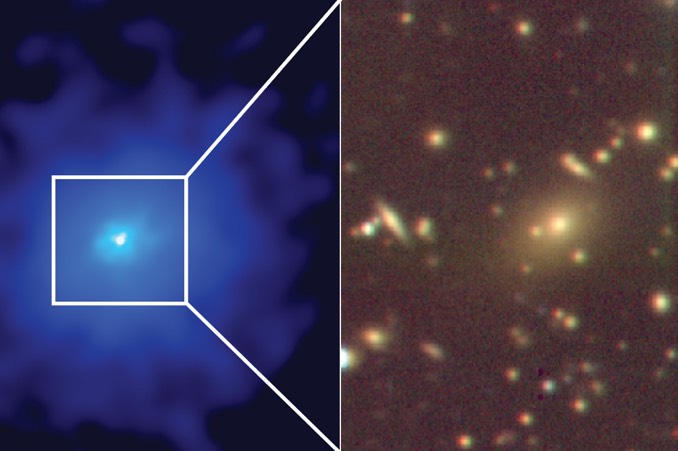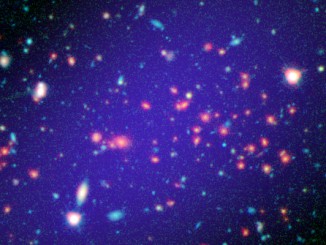
New research shows a black hole-fuelled quasar shining 46 billion times brighter than the Sun is not the lone wolf astronomers once believed. Massachusetts Institute of Technology researchers have found the quasar, PKS 1353-341, is simply so bright it drowns out the light from hundreds of galaxies in a surrounding cluster.
Michael McDonald, an assistant professor of physics at MIT’s Kavli Institute of Astrophysics and Space Research, writes in the Astrophysical Journal that the previously unseen cluster is about as massive as 690 trillion suns. For comparison, the Milky Way tips the scales at some 400 billion solar masses.
The supermassive black hole at the heart of PKS 1353-341 apparently is consuming huge amounts of material from a surrounding disk of debris, heating it to enormous temperatures as it is sucked in and generating the torrent of energy that, until now, has blocked out the light from the cluster’s hundreds of constituents.
“This might be a short-lived phase that clusters go through, where the central black hole has a quick meal, gets bright, and then fades away again,” says McDonald. “This could be a blip that we just happened to see. In a million years, this might look like a diffuse fuzzball.”
As for the quasar, its brightness “might be related to how much it’s eating.”
“This is thousands of times brighter than a typical black hole at the center of a cluster, so it’s very extreme in its feeding,” McDonald said. “We have no idea how long this has been going on or will continue to go on. Finding more of these things will help us understand, is this an important process, or just a weird thing that there’s only one of in the universe.”
The discovery of the previously unseen galaxy cluster came from a survey known as CHiPS, which stands for Clusters Hiding in Plain Sight, that is based on re-evaluating X-ray images captured earlier. The team looked for brilliant point sources embedded inside “fluffy things,” according to Taweewat Somboonpanyakul, an MIT graduate student and the paper’s lead author.
For every such candidate, the team used the Magellan Telescope in Chile to take a closer look. If a higher-than-expected number of galaxies was seen, the researchers looked for extended diffuse emissions using NASA’s Chandra X-ray Observatory.
“Some 90 percent of these sources turned out to not be clusters,” McDonald says. “But the fun thing is, the small number of things we are finding are sort of rule-breakers.”
McDonald and his colleagues say the discovery raises the possibility that other galaxy clusters may be hiding in the glare of other extremely bright sources that have been mis-identified as single objects. The team is now searching for more hidden clusters that could play a role in how fast the universe is expanding.
“If you know where all the galaxy clusters are in the universe, which are the biggest pieces in the universe, and how big they are, and you have some information about what the universe looked like in the beginning, which we know from the Big Bang, then you could map out how the universe expanded,” McDonald said.



